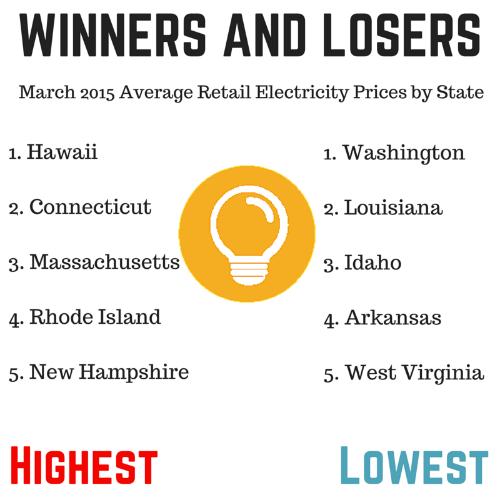The Price of Electricity per kWh
Most of us tend to only look at the bottom line when we pay our electricity bills. But a lot goes into that final number, which is why it can change so dramatically from month to month. Understanding how electricity pricing works is the first step in taking charge of your energy bills. Here we explain everything you need to know about the price of your electricity, and what you can do to keep it as low as possible.
GOT A SPECIFIC QUESTION ABOUT YOUR BILL?Call us at 1 (832) 460-0233 to learn more about the best electricity rates available in your area
What Are Prices Made Up Of
There are four main costs that go into the final price on your electricity bill:

- Your electricity use. It is measured in the unit used for electricity, a kilowatt-hour (kWh)
- Supply charges. This is the rate that you pay for your electricity supply. It is multiplied by your electricity use to get the total cost of your energy supply. The supply rate may vary depending on where you live, what type of plan you have, and general market conditions.
- Distribution and transmission charges. A good proportion of your bill goes towards paying for the infrastructure that allows electricity to be brought to your home. This includes the costs of building wires and transmission lines, as well as upkeep and maintenance to ensure that you have electricity running when you need it.
- Taxes and state surcharges. Depending on where you live, your state and/or municipality may charge taxes on your electricity use to pay for renewable energy programs, low income assistance, or other programs.
kwH: A quick definition
A kilowatt hour (kWh) is a measure of energy, like the Joule, a calorie, or British Thermal Unit (BTU). One kilowatt-hour is the amount of energy needed to power one kilowatt for one hour. This definition may sound a little abstract, so let's look at a few examples. For example, one kilowatt-hour is equivalent to:
- Watching TV for 10 hours
- Vacuum for an hour
- Washing 12 pounds of laundry
- Ironing for an hour
Find out moreLearn more about kWh and other measurements of electricity in more detail.
How much energy do my appliances use?
How much electricity your appliances use depends on how powerful they are (which is measured in Watts), as well as their energy efficiency.
| Appliances | Wattage | Un kWh of use is equivalent to… |
|---|---|---|
| Electric Furnace | 17,221 W | 3 minutes of use |
| Dryer | 3500 W | 17 minutes of use |
| Dishwasher | 1800 W | 33 minutes of use |
| Microwave | 1500 W | 40 minutes of use |
| Toaster Oven | 1200 W | 100 pieces of toasted bread 50 minutes of use |
| Iron | 1100 W | 54 minutes of ironing |
| Vacuum Cleaner | 650 W | 1.5 hours of cleaning |
| Washing Machine | 425 W | 3 Sessions of Washing Clothes |
| Laptop | 50 W | 20 hours of use |
| CFL Bulb 60 W equivalent |
18 W | 7 nights of light |
| Cell Phone Charger | 4 W | 278 Charges |
Source: General Electric
How Much Does Electricity Cost In The United States?

The average cost of retail electricity in the US is about 9.84 ¢/kWh, but this varies considerably by state. For example, Washington and Louisiana enjoys some of the lowest electricity rates in the country, at an average of about 9 ¢/kWh in March 2015, whereas in Hawaii the average price of electricity was 30.54 ¢/kWh
Why such a wide variation in prices? As you recall, there are four main factors that make up the price of electricity: how much you use, the rate you pay for supply, delivery charges, and state charges/taxes. Out of these, the cost of electricity supply and the costs of delivery generally play the biggest role in explaining how expensive electricity is (or isn't) in your state.
Supply
From wind, the sun, coal, natural gas, nuclear, or hydro, electricity can be generated from a variety of sources, but each type of electricity comes with a different price tag. Most states use a variety of generation sources for their electricity supply, but the exact proportion depends on what is most available locally. States like Washington are lucky enough to be able to take advantage of hydroelectricity, which is relatively cheap (once it has been built). Other states, such as Hawaii, do not have access to abundant and cheap sources of power, and have to rely on more expensive power sources, such as imported electricity (Hawaii imports over 90% of its electricity, mostly from oil-fired power plants).
Delivery
Another important factor in determining the overall price of your electricity is the cost of maintaining the infrastructure that brings electricity to your home. These are mostly fixed costs, that are based more on the size of the service territory and less on the number of people within it. This means that it helps to live in a relatively small area with a high population density, so that the costs can be spread out over more people. In general, people living in cities pay lower delivery costs than people living in rural areas.
Why Electricity Prices Are So Volatile
Electricity prices can change depending on the season, the weather, or even the time of day. Most power is generated, sold and delivered in real time, i.e. as it's needed. This means that any change in demand or supply can have an impact on price. With the way the majority of our electricity system is structured, power supply is fairly stable (except for unexpected situations, such as a power plant suddenly malfunctioning). Changes in demand, however, can have a strong impact on the price of electricity.
Hourly Changes
Think about it. When do you use electricity? Most people tend to use the most electricity during the day, especially in the mornings and in the evenings, before and after work. In fact, chances are the majority of the power that you use in a day is during these times. On the other hand, you probably use very little electricity at night when you're asleep. Most of us tend to follow the same patterns of when we use power. This means that during certain times of the day (known as periods of peak demand), demand for electricity is much higher than others. As electricity is traded in real time, this means that the price of electricity during peak times can be quite expensive compared to other times in the day.
Seasonal Changes
Electricity demand also changes with the seasons. Throughout the US, we tend to use the most electricity during the summer, mostly because of our use of air conditioning (which tend to use a lot of electricity). This is why the price of electricity is generally more expensive in the summer.
National Trends in Electricity Prics
While electricity prices can change depending on the region and the time of year, one thing's for certain: the average price of electricity per kilowatt-hour is steadily increasing each and every year..
How to Save On Electricity Prices
Let's get back to business with how to save you money on your electricity bills. As a reminder, your electricity price, and the number you see in bold at the bottom of your bill depend on four factors, namely:
- How much electricity you consume
- The rate you pay for your electric supply
- Delivery charges
- Taxes & state surcharges
Probably the most effective way to reduce your power bills is simply by cutting the overall amount of electricity you consume in a month. In most cases throughout the US, many delivery charges and state surcharges are also charged on a cents per kWh basis, so decreasing your monthly consumption can have a big impact on your overall energy bill (unless you live in Texas - find out why).
Depending on what you already do to conserve energy at home, cutting your monthly power consumption might be easier than you think.
- Check out some of our energy saving tips, including:
- How to be Smart With Your Appliance Use
- Vampire Energy - what it is and how to avoid it
- How to Stay Cool Without Heating up Your Summer Power Bills
Another way in which you can save money on your electric bill is to change the rate you are paying. If you live in an area where electricity markets are open to competition, you have a choice of who supplies your energy. Alternate suppliers are able to offer a variety of plans at different contract lengths, and can save you money.
To learn more about your options, give us a call us at 1 (347) 410-8789 or check out the rest of our site at callmepower.com.
